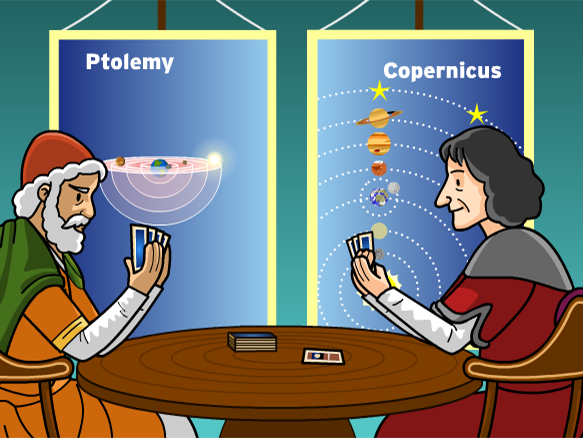
神学と科学との間における最初の,またある意味で最も注目すべき,激戦(pitched battle )は,我々が今日太陽系と呼んでいるものの中心は地球かあるいは太陽かということに関する天文学上の論争であった。(当時の) 正説(公認の理論)は,プトレマイオスの理論であった。それによると,地球は宇宙の中心で静止している一方,太陽,月,惑星,及び恒星の体系は,地球の周りを回転し,それらの各々は,自己の領域(の範囲内)にある。新しいコペルニクスの理論によると,地球は静止しているどころか,二様の運動をもっている。(即ち)地球はその軸(地軸)を一日一回転し(自転),太陽の周りを一年に一回転する(公転)。 我々がコペルニクス理論と呼ぶもの(理論)は,16世紀に,大変な目新しさをもって(with all the force of novelty),現われたが(注:荒地出版社刊の津田訳では「17世紀」と誤訳),実際は,その天文学における能力がとても高かったギリシア人によって,既に創案されていた。それはピタゴラス学派により唱道され,歴史的には多分その事実はないであろうが,ピタゴラス学派(の人たち)はその理論はピタゴラス学派の祖であるピタゴラスに帰属するとした。地球は動くと明確に教えたと思われる最初の人物は紀元前三世紀に生きていたサモス(島)のアリスタルコス(紀元前310年 – 紀元前230年頃)であった。彼は多くの点で驚嘆すべき人物であった。観察の誤差(errors 誤り)があったためにその結果(距離)は精確とはとても言えないものであったが,彼は,太陽と月との相対距離(注:両者の距離は刻々と変化するのであくまでも「相対」距離) を発見する理論的に正当な方法を考案した。ガリレオ同様,彼は不信心の非難を受け,ストア派のクレアンテス(Cleanthes)によって攻撃された。しかし,彼の生きていた時代は,頑固な迷信家は政治に対してほとんど影響を及ぼしていなかったので,そのような攻撃は明らかに彼にまったく害を与えなかった。 ギリシア人は幾何学に大変優れていたので,ある種の問題(事柄)については,科学的証明に達することを可能にした(達することが出来た)。彼らは日食の原因を知っており,月に映った地球の影の形から,地球は球体であること(a sphere 球形)を推論した。エラストテネスは -彼はアリスタルコスより少しばかり後の人物だが- 地球の大きさを概算する方法を発見した。しかし,ギリシア人は力学の初歩すら持ち合せておらず(知らず),従って,地球の運動に関するピタゴラス説を信奉する者たちは,自分たちの理論を裏付けるいかなる強力な論拠(論証)も推し進めることはできなかった。プトレマイオスは,紀元一三〇年頃に,アリスタルコスの見解を拒否し,地球を宇宙におけるその特権的地位に連れ戻した。その後,古代と中世を通じ,彼(プトレマイオス)の見解は,疑われないままの状態が続いた(のである)。
Chapter 2: The Copernican Revolution, n.1 The first pitched battle between theology and science, and in some ways the most notable, was the astronomical dispute as to whether the earth or the sun was the centre of what we now call the solar system. The orthodox theory was the Ptolemaic, according to which the earth is at rest in the centre of the universe, while the sun, moon, planets, and system of fixed stars revolve round it, each in its own sphere. According to the new theory, the Copernican, the earth, so far from being at rest, has a twofold motion : it rotates on its axis once a day, and it revolves round the sun once a year. The theory which we call Copernican, although it appeared with all the force of novelty in the sixteenth century, had in fact been invented by the Greeks, whose competence in astronomy was very great. It was advocated by the Pythagorean school, who attributed it, probably without historical truth, to their founder Pythagoras. The first astronomer who is known definitely to have taught that the earth moves was Aristarchus of Samos, who lived in the third century B.C. He was in many ways a remarkable man. He invented a theoretically valid method of discovering the relative distances of the sun and moon, though through errors of observation his result was far from correct. Like Galileo, he incurred the imputation of impiety, and he was denounced by the Stoic Cleanthes. But he lived in an age when bigots had little influence on governments, and the denunciation apparently did him no harm. The Greeks had great skill in geometry, which enabled them to arrive at scientific demonstration in certain matters. They knew the cause of eclipses, and from the shape of the earth’s shadow on the moon they inferred that the earth is a sphere. Eratosthenes, who was slightly later than Aristarchus, discovered how to estimate the size of the earth. But the Greeks did not possess even the rudiments of dynamics, and therefore those who adhered to the Pythagorean doctrine of the earth’s motion were unable to advance any very strong arguments in favour of their view. Ptolemy, about the year A.D. 130, rejected the view of Aristarchus, and restored the earth to its privileged position at the centre of the universe. Throughout later antiquity and the Middle Ages, his view remained unquestioned.
出典:Religion and Science, 1935, chapt. 2.
情報源:https://russell-j.com/beginner/RS1935_02-010.HTM
